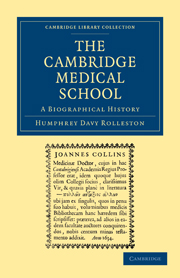Book contents
- Frontmatter
- Contents
- List of Plates
- Preface
- I The Medical School
- II Department of Anatomy
- III Department of Physiology
- IV Department of Biochemistry
- V Department of Experimental Psychology
- VI Department of Pathology
- VII Department of the Quick Chair of Biology
- VIII The Regius Chair of Physic
- IX John Caius
- X The Downing Chair of Medicine
- XI The Linacre Lectureship in Physic
- XII The Chair of Surgery
- Index of Persons
- Index of Subjects
- Plate section
II - Department of Anatomy
Published online by Cambridge University Press: 07 September 2010
- Frontmatter
- Contents
- List of Plates
- Preface
- I The Medical School
- II Department of Anatomy
- III Department of Physiology
- IV Department of Biochemistry
- V Department of Experimental Psychology
- VI Department of Pathology
- VII Department of the Quick Chair of Biology
- VIII The Regius Chair of Physic
- IX John Caius
- X The Downing Chair of Medicine
- XI The Linacre Lectureship in Physic
- XII The Chair of Surgery
- Index of Persons
- Index of Subjects
- Plate section
Summary
IN August 1565 John Caius, who was mainly responsible for the introduction of the study of practical anatomy into England, obtained from Queen Elizabeth a formal yearly grant of two bodies, of criminals or unknown strangers dying in Cambridge, for dissection in Gonville and Caius College. His statutes of that college, dated September 4, 1557, contain directions about the care of these bodies. Until the chair of anatomy was founded by the University in 1707, the Regius Professors of Physic were responsible for the teaching of human anatomy and were required to do one “anatomy” a year by a decree of 1562, and to be fined if their duties were not carried out. The Regius Professors of Physic, however, did not escape reproach in this respect, for on January 28, 1627, within three months of John Collins's accession to the chair, attention was called to their negligence and a Grace was then passed to correct this; accordingly in the following March an “anatomy” was held in the Regent House, subsequently the Catalogue Room of the Library. Again in 1646, when Glisson was Regius but much at Colchester and away from Cambridge, an order was given that the “Regius Reader in Physic” should resume his anatomical demonstrations, and the neglect of his duty “through a paltry economy” was severely condemned.
- Type
- Chapter
- Information
- The Cambridge Medical SchoolA Biographical History, pp. 47 - 78Publisher: Cambridge University PressPrint publication year: 2009First published in: 1932

